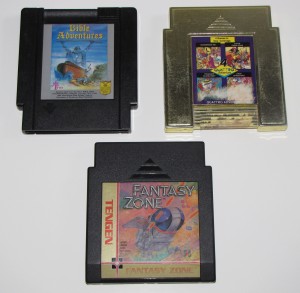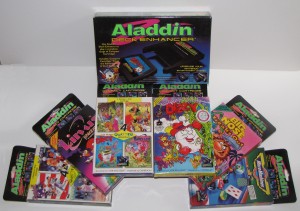Electric Curosities: Enhance your NES!
Back in the early 90’s, toward the end of the life of the NES, the company who was responsible for the Game Genie came up with another idea to make Nintendo angry. It was called the Aladdin Deck Enhancer. Reportedly designed to allow “enhanced” games on the NES by providing extra RAM and better graphics, it was called “the future of console game play” by its very own box. In reality, however, it was an ill-timed plot to sell cheap, unlicensed games for the NES.
Cartridges for the NES were fairly expensive to produce. It wasn’t just the ROM chip, a simple circuit board, and a big plastic shell, like there was in the days of the Atari. Sometimes NES games needed some extra memory, sometimes they needed a graphics coprocessor, but they always, every single one of them, needed the additional electronics to satisfy the 10NES lockout chip.
You see, Nintendo learned a lesson from the Great Crash of 83. Atari didn’t have any kind of lockout device on the Atari 2600. This allowed third party developers like Activision and Imagic to produce some of the best titles of the system without needing the permission of nor needing to pay Atari. It also allowed anyone with a ROM burner to produce mountains and mountains of unashamed garbage that masqueraded as video games. You think ET caused the Crash? No. Custer’s Revenge caused the Crash. Star Fox caused the Crash. ((Not THE Star Fox, although, interestingly enough, Star Fox for the Atari 2600 is the reason THE Star Fox had to be called “Starwing” and “Lylat Wars” in Europe. ))  Nintendo wasn’t going to let their system be killed by crappy games. The solution to this problem came in the form of the 10NES lockout.
By setting up a two-part lock electronic lock, they prevented a critical mass of lousy games from accumulating and thereby averted a full scale market implosion. ((Atari learned the same lesson. In its 7800 ProSystem console, there’s a lockout mechanism that’s so strong that it is actually against the law to export an Atari 7800 due to restrictions governing military grade cryptography. In Atari’s case, however, a second full scale market implosion was avoided, not by the lockout chip, but rather by not actually having a market that could implode.)) One part was in the console. When you put in a cartridge and turned the power on, a challenge was sent to the cartridge. If the cartridge responded properly, then you got to play the game. If the cartridge failed to respond correctly, you got a blinking power light and a flashing gray screen of death. And the only place to get the chip that acted like the key to the lock was Nintendo. They patented and copyrighted the design, so they’d sue you no matter what you tried to do to circumvent the lockout. But, Nintendo also recognized that the key to a successful console was third party support. Game publishers were welcome to make games for the NES, as long as they abided by all sorts of requirements and rules (Including censorship), and, on top of that, pay for the privilege of getting the chip for the cartridge and the “Nintendo Seal of Quality” on the box.
The program was successful. Because of it, Nintendo avoided a flood of terrible and worthless games. Sure, there were games that sucked, but for the most part, anything that had the Nintendo Seal of Quality was at least half-way decent.  Even crap-buckets like Total Recall or Super Pitfall were miles above the uninspired and derivative silicon wastelands that plagued the Atari 2600 in 1983.   The lockout chip also made piracy of NES carts more difficult. Without the 10NES key chip, a game wouldn’t play, and Nintendo wasn’t about to hand out those chips to pirates.
Of course, the flip side should be obvious. Because Nintendo controlled the chip that was the key to the system, Nintendo controlled every game that was allowed to play on it. Want to put out a game with blood in it? Nope. Want a game with strong religious themes or symbols? Ain’t gonna happen. Adult content or mature themes? Uh-uh. Want to release the same game for the NES and for Sega? Not for another couple of years. Want to put out more than a handful of games a year? Fat chance.
Don’t want to pay the licensing fee to Nintendo…?
Whenever there is a technology that will prevent someone from making money, that someone will find a way to defeat that technology, thereby allowing money to be made. That is exactly what happened with the 10NES lockout chip. Some people created pass-through carts, which looked like a Game Genie and required you to plug in a licensed NES cartridge in order to play. It then used the real 10NES chip in the licensed cartridge to unlock the NES, which then loaded the unlicensed game in the passthrough. Other companies thought that was too tacky looking and instead decided to simply fry the 10NES chip in the NES system by sending it a voltage spike. However, the truly dedicated ones reverse engineered the 10NES chip from the specifications in documents obtained under false pretenses from the US Patent Office. The corporation who was responsible for this awesome act of technological trickery? Atari. The Atari who had been nearly destroyed by unlicensed games had decided to create its own unlicensed NES games under the Tengen brand, largely to get around Nintendo’s licensing fees and severe non-compete restrictions. ((And, of course, they got sued… Although some may claim that the lawsuit was less about protecting their technology than protecting their reputation, as the lawsuit focused on the Tengen version of Tetris, generally considered superior to the Nintendo version. (Much the same way that Atari had sued Magnavox for the superior K.C. Munchkin infringing on the less-than-stellar 2600 Pac-Man…) ))

Unlicensed NES Cartridges: Bible Adventures (Wisdom Tree), Quattro Adventure (Camerica), Fantasy Zone (Tengen)
Most manufacturers of unlicensed NES games ended up following in Atari/Tengen’s shoes and created 10NES knock-off chips. However, those chips raised the cost of producing a cartridge and cut into the profit margin. Which brings us back to the Aladdin Deck Enhancer that I was talking about before I went off on that long-winded tangent of a history lesson. You see, there was nothing about the Aladdin Deck Enhancer that was really an enhancement at all.  It actually wasn’t about the extra memory, it actually wasn’t about the graphics coprocessor. It was about the knock-off 10NES chip. The plan behind the Aladdin Deck Enhancer was that they’d sell the base cartridge, which contained the lockout chip and some other chips, then sell the games that plugged into the base separately. As many games as you wanted, but only one lockout chip. The games, since they wouldn’t need to include the extra electronics, would be cheaper to produce and therefore cheaper to sell. On top of that, why not license other games for use with the Aladdin Deck Enhancer? Certainly there are other companies or game developers itching to get their games on the NES without having to deal with the Iron Fist of the Big N. It’s like a license to print money!
Or rather, in 1988, it would have been a license to print money. But the Aladdin Deck Enhancer came out in 1993, firmly in the period of 16-bit domination. If people wanted enhanced graphics and bigger games, they didn’t buy games on some convoluted half cartridge that required some bizarre mutant shell for them to work. No, they went out and bought a Super Nintendo. The company which distributed the Aladdin Deck Enhancer was ruined and folded a few months later.
The game “Dizzy The Adventurer” was included as a pack-in cartridge. The other six cartridges released were The Fantastic Adventures of Dizzy, Quattro Adventure (including Boomerang Kid, Super Robin Hood, Linus Spacehead, and Treasure Island Dizzy ((It’s obvious that Codemasters felt that Dizzy would be their killer app, with three Dizzy games available for the unit and another one promised on the box. Although apparently big in the UK, sadly, the failure of unit meant that Prince Dizzy of the Yolk Folk would remain obscure in the US…)) ), Big Nose Freaks Out, Micro Machines, Quattro Sports (including Baseball Pros, Soccer Simulator, Pro Tennis, and BMX Simulator), and Linus Spacehead’s Cosmic Crusade. ((If you’re ever in need of a Commodore 64 flashback, you should give Dizzy or the games on Quattro Adventure a spin. Not that you ever actually played those games on a C64, but they’ll certainly remind you of one.)) 11 other games were promised on the box, and while none of those were released as Deck Enhancer carts, most were later (or had already been) released as standalone unlicensed NES carts. While not crowning pinnacles of gaming glory, the Aladdin games aren’t complete abuses of the physical properties of silicon.  It’s likely that some of the games would have easily been qualified for the “Nintendo Seal of Approval”, had they wished to go legit. ((And if they hadn’t been made by the same people who made the Game Genie…))



2 comments
Maybe this is my OCD kicking in, but I swear towards the end of the NES’s life in North America, they introduced games with coprocessors to kick the graphics up to almost 16 bit quality. Some caveman game comes to mind. Also, weren’t there rumors of a CD-ROM add on too for the NES?
The Aladdin Deck Enhancer (And the standalone Camerica/Codemasters games) are probably what you’re thinking of. Those games generally had good graphics. Here’s a video someone did of Dizzy the Adventurer: http://www.youtube.com/watch?v=SOHa1jIUkrE The caveman game you’re thinking of is probably Big Nose the Caveman, which was one of the Deck Enhancer titles (And one that had a standalone release).
As far as the CD-ROM add-on, I’m not aware of any talk about one for the NES. The SNES, however, had one in development for quite a while. It got several profiles in Nintendo Power. The CD-ROM was a joint venture between Nintendo, Sony, and Philips. When the SNES CD-ROM plans fell apart, Philips continued development and released the CD-i, with a Mario game (Hotel Mario) and several Zelda games (Link: Faces of Evil, Zelda: The Wand of Gamelon and Zelda’s Adventure), which they were able to do because of some really poor contract writing on Nintendo’s part. The games were awful and the CD-i died. Sony also continued development and eventually released the Playstation…
Leave a Comment